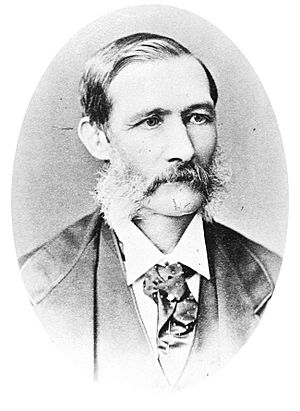Dietrich Brandis facts for kids
Quick facts for kids
Dietrich Brandis
|
|
|---|---|
 |
|
| Born | 31 March 1824 Bonn, Germany
|
| Died | 29 May 1907 (aged 83) Bonn
|
| Occupation | Botanist, forestry academic, civil servant |
| Scientific career | |
| Author abbrev. (botany) | Brandis |
Sir Dietrich Brandis KCIE FRS (born March 31, 1824 – died May 28, 1907) was an important German-British expert in plants and forests. He worked for the British government in India for almost 30 years. He is often called the "father of tropical forestry" because of his pioneering work. He also helped shape how forests are managed in the United States.
Contents
Early Life and Education
Dietrich Brandis was born in Bonn, Germany. His father, Christian August Brandis, was a well-known philosopher. Dietrich studied at universities in Copenhagen, Göttingen, and Bonn, focusing on botany (the study of plants). In 1849, he became a lecturer in botany at Bonn. At first, he was interested in forests mainly from a plant-science point of view.
In 1854, he married Rachel Marshman. Her family had connections that helped him get a job in Burma (now Myanmar) and later in India. Rachel died in India in 1862. Later, he married Katharina Hassie, and they had six children together.
Working with Forests in British India
The British government in India was very interested in using forest resources, especially timber. However, trees were being cut down without any rules, and forests were disappearing fast. By the 1850s, the government realized they needed to do something.
In Burma
In 1856, Brandis joined the British government in Burma. He became the head of the forest department there in 1858. His main job was to manage the valuable teak forests.
He started a system called "taungya." In this system, local villagers helped clear land, plant teak trees, and remove weeds. In return, they could grow their own crops between the young trees for a few years. Once the teak trees grew bigger, the villagers moved to new land and repeated the process. This system helped plant many teak trees.
Brandis had a collection of plants and books about botany, but they were lost when his boat sank. This made him focus even more on practical forest management instead of just studying plants. He worked on figuring out how much teak timber there was, how fast trees grew, and how many trees could be cut without harming the forest. He also created plans to protect forests from pests and fires. He set up special "conservancies" where forest officers managed the trees. His ideas helped create the Indian Forest Act of 1865, which set rules for managing forests.
Leading Forestry in India
In 1864, Brandis became the Inspector General of Forests in India, a very important job he held for 20 years. He wrote new forest laws and helped set up places for forest research and training. He founded the Imperial Forest School in Dehradun, which taught people how to manage forests.
Brandis also studied and protected special forest areas in India called "sacred groves." These were small forests or woodlands that local people considered holy and protected for a long time. He was one of the first people in India to connect forest protection with the local communities who lived near them.
Even after he retired, Brandis kept working on Indian forestry. When he was 75, he started writing his most important book, Indian Trees. This huge book described 4,400 different tree species. It was first published in 1906 and is still used today.
Retirement and Influence
After retiring in 1883, Brandis returned to Germany but often visited England. For several years, he lived in Kew, near London. He also helped train forestry students in England.
Brandis had a big impact on forestry in the United States. He mentored many American foresters, including Gifford Pinchot and Henry S. Graves, who later became the first and second chiefs of the U.S. Forest Service. Pinchot relied a lot on Brandis's advice for setting up professional forest management in the U.S. and creating the Forest Service. President Theodore Roosevelt even sent Brandis a special thank-you note for his help with American forests.
Brandis died in 1907 in Bonn, Germany.
Honours
Dietrich Brandis received many awards and honours for his important work:
- Honorary member of the Royal Scottish Arboricultural Society, 1874
- Fellow of the Royal Society, 1875
- Companion of the Order of the Indian Empire, 1878
- Knight Commander of the Order of the Indian Empire, 1887
- Given the honorary title Professor by the Prussian Minister for Agriculture and Forestry, 1893
- Received an honorary law degree from the University of Edinburgh, 1898
- Honorary member of the Society of American Foresters, 1904
Legacy
Many plants have been named after Dietrich Brandis to honor his contributions to botany and forestry. Some examples include:
- Cananga brandisiana
- Dendrocalamus brandisii
- Diospyros brandisiana
- Ochlandra brandisii
- Macaranga brandisii
- Millettia brandisiana
- Orophea brandisii
- Quercus brandisiana
- Ardisia brandisiana
- Iodes brandisii
- Ixora brandisiana
- Loranthus brandisanus
- The plant group Brandisia is also named after him.
Images for kids


